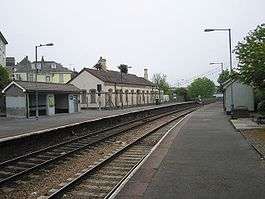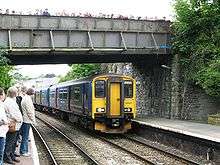Saltash railway station
| Saltash | |
|---|---|
 | |
| Location | |
| Place | Saltash |
| Local authority | Cornwall |
| Coordinates | 50°24′26″N 4°12′33″W / 50.40719°N 4.20924°WCoordinates: 50°24′26″N 4°12′33″W / 50.40719°N 4.20924°W |
| Grid reference | SX431587 |
| Operations | |
| Station code | STS |
| Managed by | Great Western Railway |
| Number of platforms | 2 |
| DfT category | F2 |
|
Live arrivals/departures, station information and onward connections from National Rail Enquiries | |
| Annual rail passenger usage* | |
| 2002/03 | 27,197 |
| 2004/05 |
|
| 2005/06 |
|
| 2006/07 |
|
| 2007/08 |
|
| 2008/09 |
|
| 2009/10 |
|
| 2010/11 |
|
| 2011/12 |
|
| 2012/13 |
|
| 2013/14 |
|
| 2014/15 |
|
| History | |
| Original company | Cornwall Railway |
| Pre-grouping | Great Western Railway |
| Post-grouping | Great Western Railway |
| Opened | 1859 |
| National Rail – UK railway stations | |
| * Annual estimated passenger usage based on sales of tickets in stated financial year(s) which end or originate at Saltash from Office of Rail and Road statistics. Methodology may vary year on year. | |
|
| |
Saltash railway station serves the town of Saltash in Cornwall, United Kingdom. It is situated on the south side of the town between the Royal Albert Bridge over the River Tamar and Coombe Viaduct which spans a small tributary of the same river. The station is managed and trains are operated by Great Western Railway.
The platform nearest the town is served by trains to Plymouth and the north, and the other platform closet to the River Tamar is served by trains to Penzance.
History

The station opened with the Cornwall Railway on 4 May 1859. It was described at the time as being "at the head of that town. It consists of an arrival and departure station, both being stone buildings, and possessing all requisite offices for the accommodation of the traffic. New and convenient approaches are likely to be made to that station by the corporation and the owners of adjoining property, which will prove a great public benefit."[1]
A goods shed was opened early in 1863 and the station was rebuilt in 1880.[2]
The Cornwall Railway was amalgamated into the Great Western Railway on 1 July 1889.[3] The Great Western Railway was nationalised into British Railways from 1 January 1948 which was in turn privatised in the 1990s.
To counter competition from electric trams, the Great Western Railway opened several small station in Plymouth and began to operate an intensive service of local trains between Saltash, Plymouth and Plympton in July 1904.[4] The services were vastly reduced after the Tamar road bridge opened in 1961.[2]
It had been hoped to restore the buildings as a visitor centre for the Royal Albert Bridge, but they have now been sold to a property developer.
Services

Saltash is served by about half the Great Western Railway trains on the Cornish Main Line between Penzance and Plymouth, including a few that run to or from London Paddington station.[5]
| Preceding station | |
Following station | ||
|---|---|---|---|---|
| St Budeaux Ferry Road | Great Western Railway Cornish Main Line |
St Germans | ||
References
- ↑ West Briton and Cornwall Advertiser, Railway Special Edition, 1859.
- 1 2 Bennett, Alan (1990). The Great Western Railway in East Cornwall. Cheltenham: Runpast Publishing. ISBN 1-870754-11-5.
- ↑ MacDermot, E T (1931). History of the Great Western Railway, volume II 1863-1921. London: Great Western Railway.
- ↑ Mosley, Brian (11 October 2008). "GWR Saltash Rail Motor Service". Encyclopaedia of Plymouth History. Plymouth Data. Archived from the original on 13 July 2006. Retrieved 13 February 2015.
- ↑ Table 51 & 135 National Rail timetable, May 2016
External links
| Wikimedia Commons has media related to Saltash railway station. |